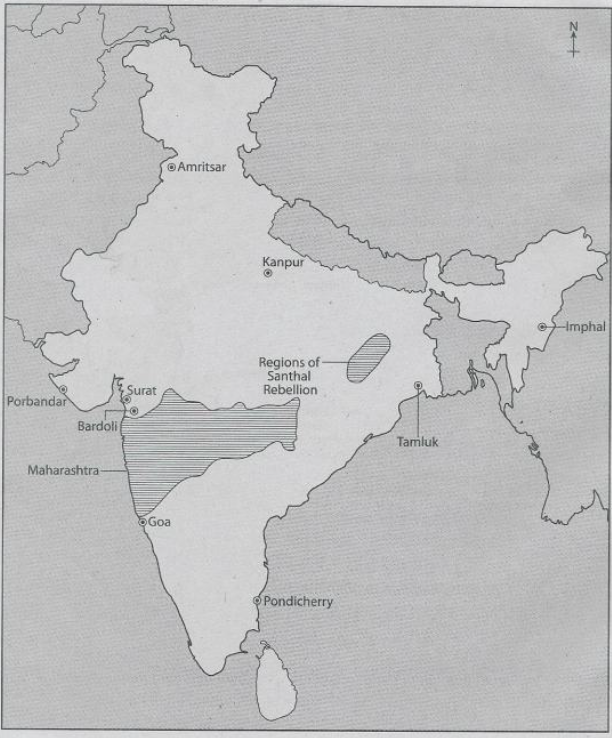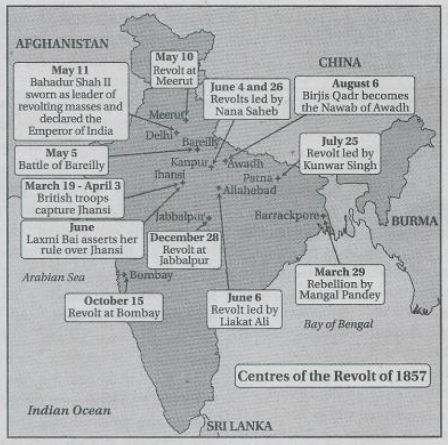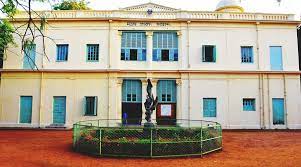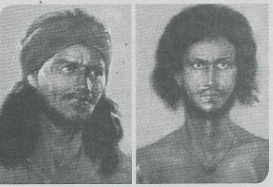WBBSE Madhyamika Model Question Paper History Group A
Choose The Correct Option
Question 1 The game of football was introduced in India by-
1. English
2. French
3. Dutch
4. Portuguese
Answer: 1. English
Question 2 Bipin Chandra Pal wrote-
1. Sattar Baths
2. Jeebon Smriti
3. Nation in Making
4. Ananda Math
Answer: 1. Sattar Baths
Question 3 The editor of Bamabodhini Patrika was-
1. Umesh Chandra Datta
2. Sisir Kumar Ghosh
3. Krisnachandra Mazumdar
4. Dwarkanath Vidyabhusan
Answer: 1. Umesh Chandra Datta
Question 4 The General Committee of Public Instruction was formed in-
1. 1713 AD
2. 1813 AD
3. 1913 AD
4. 1823 AD
Answer: 4. 1823 AD
Question 5 ‘Naba Bidhan’ was established by-
1. Dayanand Saraswati
2. Keshab Chandra Sen
3. Swami Vivekananda
4. Maharshi Debendranath Tagore
Answer: 2. Keshab Chandra Sen
Question 6 Sui Munda was the leader of-
1. Chuar Rebellion
2. Santhal Hool
3. Kol Rebellion
4. Munda Rebellion
Answer: 3. Kol Rebellion
Question 7 By the Forest Law of 1878 AD, forests were divided into-
1. Two categories
2. Four categories
3. Three categories
4. Five categories
Answer: 3. Three categories
Question 8 The Great Revolt of 1857 was described as India’s First War of Independence by-
1. Subhas Chandra Bose
2. Jawaharlal Nehru
3. V D Savarkar
4. Rashbehari Bose
Answer: 3. V D Savarkar
Question 9 The first political association of India was-
1. Indian Association
2. Indian National Congress
3. Bangabhasha Prakashika Sabha
4. Landholders’ Society
Answer: 3. Bangabhasha Prakashika Sabha
Question 10 ‘Bharat Mata’ was painted by-
1. Abanindranath Tagore
2. Rabindranath Tagore
3. Nandalal Bose
4. Gaganendranath Tagore
Answer: 1. Abanindranath Tagore
Question 11 The process of Half-tone printing was introduced in India by-
1. Upendrakishore Roychowdhury
2. Sukumar Roy
3. Panchanan Karmakar
4. Charles Wilkins
Answer: 1. Upendrakishore Roychowdhury
Question 12 Vishva-Bharati was founded by-
1. Ishwarchandra Vidyasagar
2. Rabindranath Tagore
3. Swami Vivekananda
4. Debendranath Tagore
Answer: 2. Rabindranath Tagore
Question 13 The leader of the ‘Eka’ movement was-
1. Madari Pasi
2. Dr. Ambedkar
3. Mahatma Gandhi
4. Baba Ramachandra
Answer: 1. Madari Pasi
Question 14 All India Trade Union Congress was founded in-
1. 1917 AD
2. 1927 AD
3. 1920 AD
4. 1929 AD
Answer: 3. 1920 AD
Question 15 The Bardoli Satyagraha was held in-
1. Bombay
2. Punjab
3. Madras
4. Gujarat
Answer: 4. Gujarat
Question 16 The Anti-Partition movement in Bengal had taken place in-
1. 1904 AD
2. 1906 AD
3. 1905 AD
4. 1911 AD
Answer: 3. 1905 AD
Question 17 Matangini Hazra was associated with the Quit India Movement in-
1. Tamluk
2. Sutahata
3. Barishal
4. Purulia
Answer: 1. Tamluk
Question 18 Dipali Sangha was founded by-
1. Kalpana Datta
2. Lila Nag (Roy)
3. Basanti Devi
4. Bina Das
Answer: 2. Lila Nag (Roy)
Question 19 ‘Iron Man of India’ refers to-
1. Mahatma Gandhi
2. Sardar Vallabhbhai Patel
3. Muhammad Ali Jinnah
4. Rajendra Prasad
Answer: 2. Sardar Vallabhbhai Patel
Question 20 ‘A Train to Pakistan’ was written by-
1. Jawaharlal Nehru
2. V P Menon
3. Khushwant Singh
4. Salman Rushdie
Answer: 3. Khushwant Singh
WBBSE Madhyamika Model Question Paper History Group B
Answer Any Sixteen Questions Taking At Least One From Each Segment
Question 1 Who was the editor of ‘Somprakash’?
Answer:
The editor of ‘Somprakash’ was Dwarkanath Bidyabhusan.
Question 2 Where are government documents preserved?
Answer:
The government documents are preserved in Mahafiz Khana.
Question 3 Which century is called the ‘century of Renaissance in Bengal’?
Answer:
The 19th century is called the century of Renaissance in Bengal.
Question 4 What is meant by ‘Ulgulan’?
Answer:
‘Ulgulan’ means Great Tumult.
WBBSE Madhyamika Model Question Paper History State whether True or False
Question 1 The Ramakrishna Mission was set up by Sri Ramakrishna.
Answer: False
Question 2 Lord Dalhousie was the Governor-General of India during the Great Revolt.
Answer: False
Question 3 Rabindranath Tagore supported the cause of the European community through the novel ‘Gora’.
Answer: False
Question 4 Gandhiji and Dr. Ambedkar jointly fought for the rights of the Dalits.
Answer: False
WBBSE Madhyamika Model Question Paper History Match column ‘A’ with ‘B’.
| Column 1 | Column 2 |
| (1) Aurobindo Ghosh | (A) Indian national Army |
| (2) Taraknath Palit | (B) Bengal national School and College |
| (3) Nabagopal Mitra | (C) Bengal Technical Institute |
| (4) Rashid ALi | (D) Hindu Mela |
Answer: 1-B,2-C,3-D,4-A
Question 1 On the given outline map of India, locate and label the following places.
1. Regions of the Santhal Rebellion
Answer:
2. A center of the Indigo Revolt
Answer:
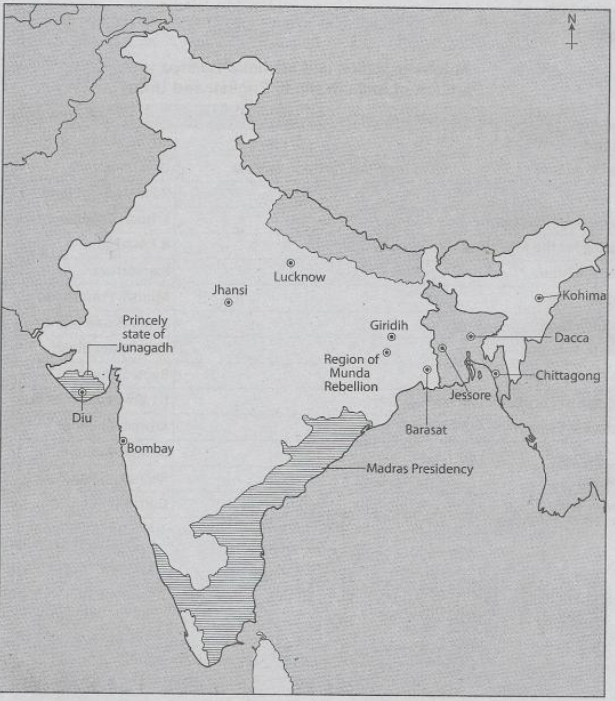
3. The princely state of Hyderabad
Answer:
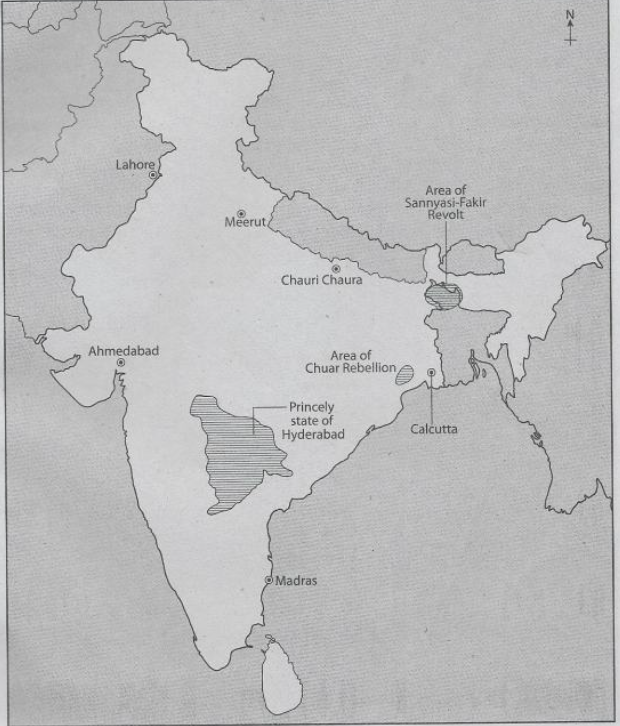
4. The reorganized state of Gujarat
Answer:
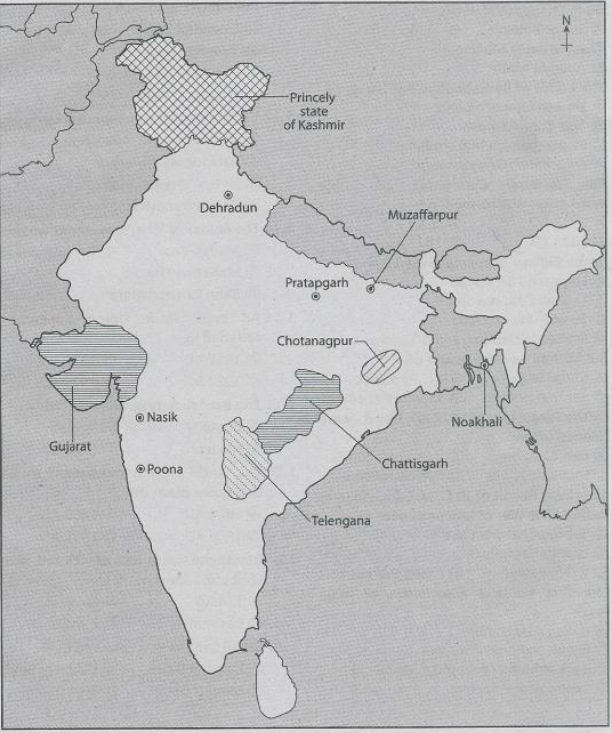
Match The Statements Below With Their Appropriate Explanation:
Question 1 Statement: The ‘Eka’ Movement was organized in Uttar Pradesh.
Explanation 1: This was an individual movement.
Explanation 2: This was a peasant movement.
Explanation 3: This was a workers’ movement.
Answer:
Explanation 2: This was a peasant movement.
Question 2 Statement: The Government of India framed the Meerut Conspiracy Case in 1929
Explanation 1: To suppress the revolutionaries.
Explanation 2: To suppress the Civil Disobedience Movement.
Explanation 3: To suppress countrywide communist activities.
Answer:
Explanation 3: To suppress countrywide communist activities.
Question 3 Statement: The leftists played an important role in the anti-colonial movements of 20th Century India.
Explanation 1: The leftists were the supporters of zamindars and industrialists.
Explanation 2: They were supporters of British imperialism.
Explanation 3: They were the supporters of the united struggle of peasants and workers against British rule.
Answer:
Explanation 3: They were the supporters of the united struggle of peasants and workers against British rule.
Question 4 Statement: Indian Women participated in the national movement for the first time during the anti-partition movement
Explanation 1: Because they were inspired by Gandhiji.
Explanation 2: Because they were the inspired by revolutionary theories of Aurobindo Ghosh.
Explanation 3: Because they wanted to boycott foreign goods.
Answer:
Explanation 3: Because they wanted to boycott foreign goods.
WBBSE Madhyamika Model Question Paper History Group C
Answer The Following Questions In Two Or Three Sentences
Question 1 What is Social History?
Answer:
Social History:
Social history is a branch of history that studies the experiences of the daily life of people and their social and economic relationship. It also includes religious and cultural affairs such as literature, education, music, etc., and fine arts. It was written between 200 BC and 200 A4. It contains 6000 hymns. It is attributed to Bhasa Muni.
Question 2 What is the importance of newspapers as a source of History?
Answer:
The importance of newspapers as a source of History is as follows-
[1] We get an idea about the political history of a nation from the contemporary political news published in newspapers.
[2] We also come to know about the contemporary culture and society of a state or a country from related news published in newspapers.
[3] News relating to the contemporary government and its mode of functioning provides us with knowledge of the history of the evolution of that state.
[4] A fair idea can be gathered about the contemporary rebellions and uprisings from newspapers.
[5] Public opinion about any contemporary event can be perceived through news published in newspapers.
Question 3 Analyse the role of Raja Radhakanta Deb in promoting women’s education in Bengal.
Answer:
The role of Raja Radhakanta Deb in promoting women’s education in Bengal:
Raja Radhakanta Deb, the zamindar of Sobhabazar, played a pivotal role in promoting women’s education in Bengal during the 19th century. Although he was a follower of orthodox Hinduism, he strongly supported the cause of women’s education and set up many educational institutes for them.
Being a member of the Calcutta School Book Society (established in 1817), he helped in setting up a number of co-ed institutions. Radhakanta Deb also published Vidyalankar’s ‘Strisikshabidhayak’, which influenced the development of women’s education.
Question 4 Why was there a rift in the Brahmo Samaj of India?
Answer:
There a rift in the Brahmo Samaj of India:
Several factors were responsible for the rift in the Brahmo Samaj, among which the most prominent ones involved Keshab Chandra Sen himself, who was the then leader of the Brahmo Samaj. His affinity towards the British, belief in the reincarnation of God, his doubts about the concept of women’s liberation, and getting his 14 year old daughter (who was a minor) married to the Maharaja of Cooch Behar led to dissatisfaction among his followers.
Thus, his followers gave up the Bharatvarshiya Brahmo Samaj (led by Keshab Chandra Sen) and founded the Sadharan Brahmo Samaj. The latter was established in 1878 by Shibnath Shastri, Bijoy Krishna Goswami, Anandmohan Basu, Dwarkanath Gangopadhyay, and Durgamohan Das.
Question 5 Was the Farazi movement a movement of religious revival?
Answer:
The planters tortured the indigo cultivators in many ways.
For instance-
[1] The planters oppressed the cultivators and forced them to grow indigo instead of other crops.
[2] If the peasants declined to cultivate indigo, they were subjected to inhuman torture.
[3] The planters even evicted the peasants from their own villages in order to augment the plantation areas.
[4] The planters also went to the extent of burning down the peasants’ huts, abducting peasant women as well as forcibly taking away their livestock.
Question 6 Briefly describe how the planters tortured the indigo cultivators.
Answer:
The planters tortured the indigo cultivators:
In the second half of the 19th century, India witnessed the spread of Western education as well as the awakening of nationalism among the masses. These events resulted in the formation of several political organizations in the 19th century by people of different levels of society. So, this period has been aptly termed as the ‘age of associations’ by Dr. Anil Seal.
Question 7 Why is the second half of the nineteenth century called the ‘age of associations’?
Answer:
The second half of the nineteenth century called the ‘age of associations’:
In the second half of the 19th century, India witnessed the spread of Western education as well as the awakening of nationalism among the masses. These events resulted in the formation of several political organizations in the 19th century by people of different levels of society. So, this period has been aptly termed as the ‘age of associations’ by Dr. Anil Seal.
Question 8 How did the novel ‘Ananda Math’ inspire the spirit of nationalism?
Answer:
The novel ‘Ananda Math’ inspire the spirit of nationalism:
‘Anandamath’, by Bankim Chandra Chattopadhyay, published in 1882, is a fitting example of a literary work that aroused feelings of national consciousness among the Indian people. The message conveyed by this book to the Indians is to sacrifice their lives for the freedom of their motherland from British rule.
It states patriotism is the highest possible virtue. The song ‘Bande Mataram’, which features in this novel, became the national hymn. ‘Anandamath’ was translated in different Indian languages, due to which a number of people were inspired by its content.
Question 9 What was the role of the Indian Association for the Cultivation of Science in the development of Scientific Education in Bengal?
Answer:
the role of the Indian Association for the Cultivation of Science in the development of Scientific Education in Benga:
The Indian Association for the Cultivation of Science played an important role in the development of scientific education in Bengal during the 19th century because of the following reasons
[1] Scientific research was regularly conducted in different fields of physics and chemistry.
[2] Many renowned scientists and researchers from different countries came here to conduct their experiments and deliver lectures for popularising science.
[3] ‘Indian Journal of Physics’ was started with a view to publishing different scientific research works carried out in this institute.
Question 10 What was the objective of founding Vishva-Bharati?
Answer:
The objectives of founding Visva-Bharati were
[1] Proper integration of the educational philosophies of the West with that of the East.
[2] Harmonization of the educational ideals of the past and the present.
[3] Encouraging creative learning within a natural environment. With these objectives in mind, Rabindranath Tagore founded the Visva Bharati.
Question 11 With what objectives was the All India Trade Union Congress founded?
Answer:
The objectives for the establishment of the All India Trade Union Congress were-
[1] Including India as a member of the International Labour Organization,
[2] Launching a well-organized labor movement besides the anti-imperialist movements against the British,
[3] Meeting the rightful demands of the laborers.
Question 12 Why was the Workers’ and Peasants’ Party formed?
Answer:
The Workers’ and Peasants’ Party was formed due to the following reasons-
[1] Organizing workers’ and peasants’ movements against the oppression of the British on the working class.
2] For protecting the interests of the workers, laborers, and peasants.
[3] propagating the ideals of communism among people through periodicals and journals.
[4] For unifying the leftist groups.
Question 13 Why was Rashid Ali Day observed?
Answer:
Various student movements started in Calcutta in protest against the judgment given to Abdul Rashid, the captain of the Azad Hind Fauj. Rashid Ali was given 7 years of rigorous imprisonment in the trial which was held in the Red Fort at Delhi.
In protest against this, the Muslim Students’ League and the All India Students’ Federation called a Students’ Strike for the release of Captain Rashid Ali from prison. This day was later celebrated as Rashid Ali Day.
Question 14 Who are known as Dalits?
Answer:
Dalits:
From 1930, non-Brahmins, low caste Hindus and the untouchables came to be known as ‘Dalits’. Gandhiji termed them as Harijans. They represented the most exploited and poorest section of society.
Question 15 What is meant by the Instrument of Accession?
Answer:
Instrument of Accession:
After the independence of India the British government left the princely states free to join either India or Pakistan. The Instrument of Accession was as a legal document to enable each of the rulers of the princely states to join one of the new dominions of India or Pakistan created by the Partition of British India. The princely states were to be given freedom in their intellectual.
Question 16 Why was the Nehru-Liaquat Pact (1950) signed?
Answer:
The Nehru-Liaquat Pact (1950) was signed mainly to guarantee the rights of the minorities of India and Pakistan. The pact ensured peaceful cooperation between the two countries, safe transport of the refugees to their respective motherlands and proper return of their ancestral property, safe return of abducted refugee women as well as other related issues.
WBBSE Madhyamika Model Question Paper History Group D
Answer Any Six Questions In Seven Or Eight Sentences, Taking At Least One From Each Segment
Question 1 Write a brief note on Women’s History.
Answer:
Women’s History:
The subject matter of History involves the whole of mankind, about half of which is comprised by women. However, it can be noted that even in the previous century, women were not given as much importance as men in the pages of history. The study of the role of women in history over time, which is known as women’s history, has begun only recently.
[1] Role of women in history: Women have contributed much to the history of every era. Nefertiti, Cleopatra, Razia, Nur Jahan, Durgavati and several other female figures have been known to have gained immense political power in the Ancient and Middle Ages. Since then, till date, there have been a number of instances where women have occupied leading social, economic and political positions in different countries all over the world.
[2] Neglect of women in history: Though the revolts, battles, and political and diplomatic activities of men have been recorded in history, the same has not been done in the case of women. Female leaders, struggles by women for their rights, their demands, their movements, and their progress in art and culture-all have not been given enough importance in history.
[3] The inception of women’s history: In recent times, researchers have started giving importance to the role of women in shaping history. It was only in the 1970s that women’s history began to come into the limelight. As a result, women’s history is gradually gaining prominence at present.
[4] Women’s history in the West: In the past few years, women’s history has gained importance in the West as well. Thus, a number of books dealing with this topic have been written by scholars like Joan Kelly, Gerda Lerner, Betty Friedan, and Judith Butler.
[5] Women’s history in India: In India, women’s history has developed at the hands of prominent scholars like Neera Desai, Geraldine Forbes, B R Nanda and Kamla Bhasin. In West Bengal, women’s history gained importance in the works of scholars like Dinesh Chandra Sen, Ramendra Choudhury, Chitra Deb, Johra Parul, Maleka Begum and Mahmood Shamsul Haque.
Question 2 Explain Swami Vivekananda’s ideals of religious reform.
Answer:
Swami Vivekananda’s ideals of religious reform:
Swami Vivekananda (1863-1902 AD) was a representative of spiritualism, patriotism and nationalism in India in the 19th century. The ideal of religion that he propagated came to be known as ‘Neo- Vedanta’. Let us now look into his ideas of religious reform.
[1] Aim: Vivekananda experienced poverty and grief in his personal life. He also witnessed the poor living conditions of the people of India. These, combined with the teachings of Sri Ramakrishna, influenced him to think deeply about the concept of religion in India.
He wanted to free people from the clutches of meaningless rituals that were closely related to religion in his times. His aim was to instill in people the idea that selfless service to man was actual service to God.
[2] A new interpretation of religion: The propounder of the ancient philosophy of Advaita Vedanta in India was Sri Adi Shankaracharya (788-820 AD). Swami Vivekananda gave a new interpretation to the Advaita philosophy, which came to be known as ‘Neo-Vedanta’. He explained that Lord Brahma was present everywhere and to serve other human beings was to serve Him.
[3] Chicago Summit: Swami Vivekananda attended the Parliament of Religions in Chicago, USA in 1893 (September 11- 27). There, he talked about the ideals of universal tolerance, love, and brotherhood as mentioned in Advaita Vedanta.
[4] ‘Samadhi’ or trance: ‘Samadhi’, a state of trance, was not given much importance in the Advaita philosophy. But, in his concept of Neo-Vedanta, Swami Vivekananda emphasised ‘samadhi’ as a process for human beings to attain salvation.
Question 3 Why did the Santhals rebel in 1855?
Answer:
The nature of the Santhal Rebellion, which broke out in 1855, was as follows-
[1] It was a rebellion of the tribal people against the colonial rulers.
[2] It was a protest of the poor peasants and workers against British imperialism.
[3] By nature, it was a resistance movement of the peasants and laborers against the British rule-supported by the potters, weavers, chamars, and domes.
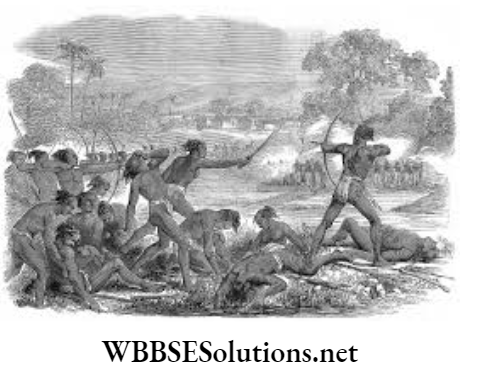
Question 4 What was the attitude of the educated Bengali society towards the Great Revolt (1857)?
Answer:
The attitude of the educated Bengali society towards the Great Revolt (1857):
The educated Indians did not take an active part in the Revolt of 1857, rather, they went against it. Almost all the revolutions which succeeded in the world had the support and cooperation of the educated classes, who became the leaders of the revolution. However, it did not go along similar lines in the Revolt of 1857.
The educated Bengalis were afraid because their newly acquired services landed property, title, honour, prestige-everything dependent on British supremacy. If the revolt became successful, they would lose everything. This was why educated Bengalis, with one or two honourable exceptions, competed with each other to prove their loyalty to the British and failed to respond even emotionally to the call of rebels.
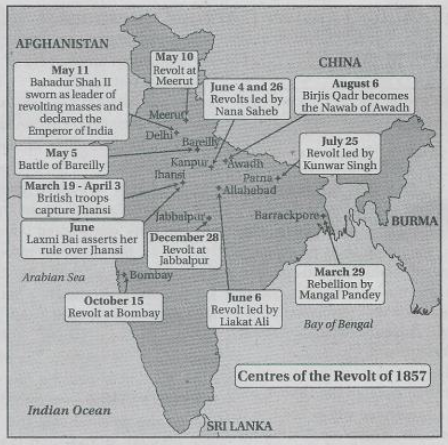
Question 5 Explain the relationship between printed books and the spread of education.
Answer:
The relationship between printed books and the spread of education:
During the 18th and 19th centuries people of India were largely illiterate. With the introduction of printed books dissemination of knowledge became easy.
[1] Printed books were cheaper than handwritten books and the public could afford to buy printed books which helped in the dissemination of knowledge.
[2] The Bible, the Ramayana, the Mahabharata and other Indian literary works, as well as various textbooks, were printed and translated in several languages such as Bengali, Hindi, Marathi, and so on. These translated books were made available to the people even in rural areas.
[3] Newspapers were printed and published, which helped in the dissemination of education among students and even among women.
[4] Cheaply printed books were made available to the students which helped in the spread of education among them.
[5] Literacy spread as more people were able to read in their mother tongue.
Question 6 What was the role of Bengal Technical Institute in the development of technical education in Bengal?
Answer:
The role of Bengal Technical Institute in the development of technical education in Bengal:
Bengal Technical Institute was established by Taraknath Palit in Calcutta in 1905 when the Swadeshi Movement started against the partition of Bengal.
Its contributions towards the spread of technical education are as follows-
[1] Initiative for national education: During the Swadeshi Movement, an attempt was made to establish a national system of education as an alternative to the education system of the British government. One of the objectives of national education was the spread of indigenous technical education. So Taraknath Palit, an Indian lawyer, founded the Bengal Technical Institute in Calcutta on July 25, 1906.
[2] Association with other institutes: In order to spread the indigenous system of education, Bengal Technical Institute merged with Bengal National College in 1910 and formed the Bengal National College and Technical School. This joint institution was renamed the College of Engineering and Technology (CET) in 1928.
[3] Activities: After the merging of the institutions, arrangements were made for the cultivation of various subjects like Physics, Chemical Technology, Industrial Technology etc., besides the disciplines of Humanities. As a result, several educated Bengalee youths could receive technical education and become self-dependent.
[4] Journals: The students of the College of Engineering and Technology, published a journal named ‘Tech’. They dedicated the first edition of this journal to those who had dreamt of national education during the age of the Swadeshi Movement.
Question 7 Write a note on the debate between Gandhi and Ambedkar on Dalit rights.
Answer:
The debate between Gandhi and Ambedkar on Dalit rights:
‘Dalits’ or the ‘untouchables’ were excluded from the four-fold varna system and formed the unmentioned fifth varna, and so they were also called ‘Panchama’. Both Mahatma Gandhi and B R Ambedkar were aware of the problem of very much untouchability of the Dalits but they held two opposite views regarding the Dalit issue.
To Gandhiji, the untouchables, who came to be known as ‘Dalits’, were an integral part of the Hindu fold. However, to Ambedkar, the ‘Dalits’ were not a part of the Hindus. Gandhiji was against separating Dalits from Caste Hindus by creating a separate electorate for them.
To Ambedkar, Dalits were ‘a part apart’ a group of uniquely oppressed people and stood for the annihilation of caste. In the First and Second Round Table Conferences, Ambedkar supported separate electorates for the Dalits, but to Gandhiji, the untouchables (Dalits) were a part of Hinduism and a separate electorate for them would create a division in Hinduism.
When Ramsay MacDonald’s Communal Award was announced, giving separate electorates to Dalits, Gandhiji protested with a fast unto death, and this brought him into direct confrontation with Ambedkar. For Ambedkar, the problem was simple. He argued that after Gandhiji’s death, in villages throughout India, there would be programs directed against Dalits and massacres.
Ambedkar surrendered and the Poona Pact formalized this with reserved seats for Dalits. According to the Poona Pact (24th September 1932), the system of a separate electorate for the Dalits was canceled. In exchange, the reserved seats for the Dalits were increased from 71 to 147.
In the Central Legislature 18% of the seats which were allotted to the general electorate for British India, were reserved for the Dalits. After their release from Poona Jail, Gandhiji engaged himself with the movement of the Dalits whom he called ‘Harijan’. On the other hand, Ambedkar could not accept the Poona Pact from the core of his heart.
So he continued to keep away from the Congress, dominated by the leaders belonging to the upper caste. On the other hand, he took initiative to safeguard the interests of the Dalits separately. With this end in view, he established a political association named the ‘Independent Labour Party’.
In order to unite all the Dalit groups of different regions of India, he formed All India Scheduled Caste Federation in July 1942. At last, he challenged Gandhi in 1956 and gave up all relations with Hinduism.
Question 8 How was India reorganized on the basis of language after independence?
Answer:
India has been a multilingual country since ancient times. After independence, the question of determining the official language for united India became a vital issue.
[1] Controversy: A controversy arose as to which language should be used to maintain communication between the central and state governments as well as for the transaction of central government issues.
The controversy mainly revolved around English and Hindi languages. Finally, in 1950, the Hindi language was recognized as the official language by the Constitution.
[2] Official Languages Commission (1955): The Official Languages Commission was formed in 1955.
The recommendations in the report of the commission are as follows-
[1] The Hindi language will be the official language of India.
[2] The use of English in official work will continue till January 26, 1965.
[3] After January 26, 1965, Hindi will be the sole official language.
[3] Official Languages Act (1953): The Official Languages Act was passed by the Indian Parliament in 1963.
This act stipulated that-
[1] English will continue to be used in official work along with Hindi, even after 1965.
[2] The state legislatures will get the right to determine the official language for their respective states.
[4] Official languages in 1964: According to the Official Languages Act 1963, the different state legislatures determined their respective state languages. As a result 14 Indian languages were included as official languages in the 8th Schedule of the Indian Constitution.
These languages were-
[1] Assamese,
[2] Bengali,
[3] Gujarati,
[4] Hindi,
[5] Kannada,
[6] Kashmiri,
[7] Malayalam,
[8] Marathi,
[9] Oriya,
[10] Punjabi,
[11] Sanskrit,
[12] Tamil,
[13] Telugu and
[14] Urdu.
WBBSE Madhyamika Model Question Paper History Group E
Answer Any One Question In Fifteen Or Sixteen Sentences
Question 1 What was the Anglicist-Orientalist Controversy in the field of education? Discuss the role of Calcutta University in the spread of higher education.
Answer:
The Anglicist-Orientalist Controversy in the field of education
1st part: Earlier the discussion of history included only the tales of royal families, the rise and fall of dynasties, the exploits of heroes and generals, the lifestyle of the upper classes, and so on. However, in recent times the study of history has become more interesting and diversified due to the inclusion of several new topics.
These are as follows—
(1)Activities of kings: History still continues. to discuss wars, conquests, the establishment of peace, treaties, the rise and fall of dynasties, etc.
(2)Discussion about the elite class: The discussion about the aristocrats, landlords, feudal lords, etc., still constitutes an important part of historical discussion.
(3)Discussion about the common people: Though the lifestyle, food habits, dress, art and culture, sports, environment, etc-., of the common people were neglected in earlier times, nowadays these aspects of common life have found much importance.
(4)Local History: Nowadays much importance is being given to the study of local and regional history. So the people of all continents, countries, cities, and villages have now been included in the purview of history.
(5)History of science: The study of history also includes the continuous development of science, technology, and medical science since ancient times.
2nd part: The British wanted to promote higher education prevalent in India, modeled on the system of education in the West. With this view, the University of Calcutta was established at the time of Lord Canning in 1857 (January 24). The role of this university in spreading higher education in India is immense.
[1] Western system of education: The University of Calcutta is the oldest of the modern universities in India. It was also the first Western-style university in the whole of Asia. Initially, higher education in the region extending from Lahore to Rangoon as well as Sri Lanka was supervised by this university.
[2] Excellence in education: The level of education in this university reached its peak of excellence during the Vice- Chancellorship of Sir Asutosh Mukhopadhyay (1906-14 and 1921- 23). It was during his time that research works in the fields of arts and science gained worldwide recognition. Many scholars from around the world came and taught here on his request. Rabindranath Tagore himself was a chief examiner at this university.
[3] First graduates: Jadunath Bose and Bankim Chandra Chatterjee became the first graduates from the University of Calcutta in 1858. The first D.Litt. in Asia, Benimadhab Barua, was also a student of this university.
[4] Noteworthy students: Some of the noteworthy students of this university were Jagadish Chandra Bose, Prafulla Chandra Ray, Satyendra Nath Bose, Meghnad Saha, C.V. Raman, Sarvepalli Radhakrishnan, R.C. Majumdar, Suniti Kumar Chatterji, Niharranjan Roy and Subhas Chandra Bose. All of them are known for their exceptional contributions in different fields.
Question 2 Briefly discuss the nature of the Great Revolt of 1857.
Answer:
The nature of the Great Revolt of 1857:
Debates exist on the nature or character of the Revolt of 1857.
These can be discussed as follows-
[1] Sepoy Mutiny: Akshay Kumar Dutta, Harish Chandra Mukhopadhyay, Dadabhai Naoroji, Charles Rex, and several others termed the Revolt of 1857 to be merely a mutiny of the sepoys. According to Charles Rex, “It was only an uprising of the sepoys.”
[2] Revolt of landlords: Rajani Palme Dutt, Ramesh Chandra Majumdar, Surendranath Sen, and others have opined that the Revolt of 1857 was mainly an uprising of the orthodox and feudal powers. According to them, feudal lords such as Nana Saheb, Rani Laxmi Bai, Kunwar Singh, etc., participated in this revolt in order to achieve their own objectives.
[3] Revolt of the masses: Historians such as Norton, Malleson, Ball, John Kay, etc., noticed the participation of the common people in this revolt and termed it as a revolt of the masses. According to them, this revolt spread fast from Delhi, Lucknow, Awadh, Kanpur, Bareilly, Jhansi, and Bihar into other parts of the country.
[4] National revolt: Historians Outram, Duff, Robertson, the Tory leader Disraeli, the socialist Karl Marx, and several others have termed this revolt to be a national revolt. According to them, apart from the sepoys of Muzaffarnagar, Bihar, and Uttar Pradesh, civilians and people from the zamindar class also launched anti-British movements during this stage.
[5] The first war of independence: Revolutionary leader V D Savarkar and some others call the Revolt of 1857 the first war of Indian independence. Professor Harinath Mukhopadhyay, Professor Susobhan Sarkar, etc., also give this revolt the name of a national struggle for Indian freedom.
[6] Great Revolt: Several nationalist historians have pointed out the popularity of the revolt in different levels of society, and thus term it the Great Revolt.

